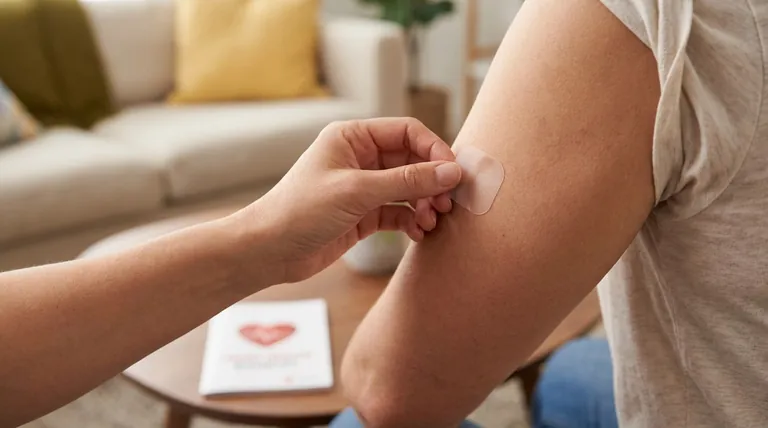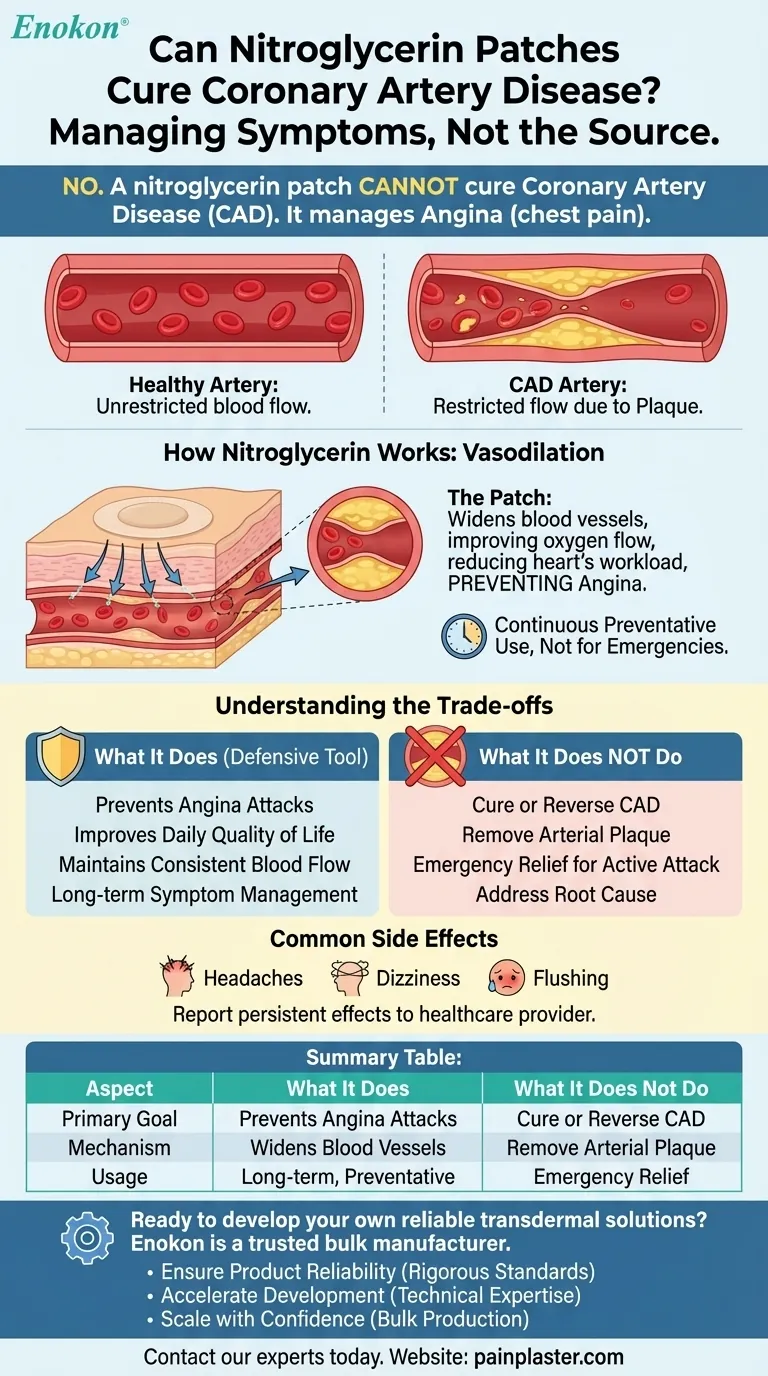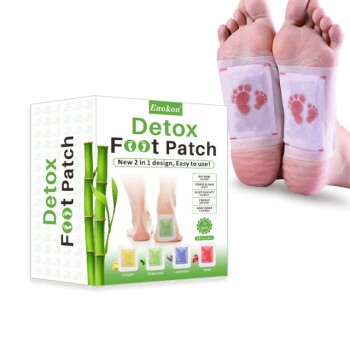No, a nitroglycerin patch cannot cure coronary artery disease. Its purpose is not to reverse the underlying condition but to manage one of its most common symptoms: angina, or chest pain. The patch works by preventing these painful episodes from occurring, making it a critical tool for symptom management rather than a cure.
A nitroglycerin patch is a preventative measure designed to manage angina by widening blood vessels. It does not address the root cause of coronary artery disease, which is the buildup of plaque in the arteries.

How Nitroglycerin Works: Managing Symptoms, Not the Cause
To understand the patch's role, it's essential to distinguish between the disease and its symptoms. Coronary artery disease (CAD) is a long-term condition, while angina is the chest pain that results from it.
The Problem: Restricted Blood Flow
Coronary artery disease is characterized by the narrowing of arteries that supply blood to the heart muscle. This narrowing, caused by a buildup of plaque (atherosclerosis), restricts the flow of oxygen-rich blood.
The Solution: Widening the Blood Vessels
Nitroglycerin is a vasodilator. When absorbed through the skin from the patch, it works to relax and widen blood vessels throughout the body.
The Result: Easing the Heart's Workload
By widening the arteries, the patch allows more blood to reach the heart muscle. This improves oxygen supply and reduces the heart's workload, which effectively prevents angina attacks from happening in the first place.
Why Continuous Use is Critical
The nitroglycerin patch is designed for prevention, not for emergency use. Its effectiveness depends entirely on consistent and correct application as prescribed by your doctor.
A Proactive Defense
The patch delivers a slow, steady dose of medication over many hours. This maintains a protective level of nitroglycerin in your system to keep blood vessels relaxed and prevent pain before it starts.
The Importance of Consistency
You must continue to use the patch exactly as directed, even on days when you feel perfectly well. Stopping the medication can leave you unprotected against angina and should only be done under the guidance of your healthcare provider.
Understanding the Trade-offs and Side Effects
While highly effective for managing symptoms, it is crucial to recognize the patch's limitations and potential side effects. This is not a "cure-all" and functions as one part of a larger treatment strategy.
It Does Not Address Plaque Buildup
The patch does absolutely nothing to remove or reduce the arterial plaque that causes CAD. Curing or reversing the disease requires other interventions, including lifestyle changes and different medications.
Common Side Effects
Because nitroglycerin widens blood vessels, some common side effects can occur. These often include headaches, dizziness, or flushing of the skin.
When to Contact Your Doctor
These side effects are often temporary, but you should report them to your healthcare provider if they persist or become particularly bothersome. They may be able to adjust your treatment plan.
The Role of the Patch in Your Overall Treatment Plan
Think of the nitroglycerin patch as a defensive tool that improves your daily quality of life while you and your doctor work on treating the underlying disease.
- If your primary focus is preventing chest pain (angina): The patch is a key preventative tool prescribed to maintain consistent blood flow and keep you symptom-free.
- If your primary focus is treating the underlying disease: The patch must be combined with the lifestyle changes and medications your doctor prescribes to manage cholesterol, blood pressure, and plaque buildup.
Using a nitroglycerin patch as directed is a powerful way to manage your symptoms and maintain an active life.
Summary Table:
| Aspect | What a Nitroglycerin Patch Does | What It Does Not Do |
|---|---|---|
| Primary Goal | Prevents angina (chest pain) attacks | Cure or reverse coronary artery disease |
| Mechanism | Widens blood vessels to improve blood flow | Remove arterial plaque (atherosclerosis) |
| Usage | Long-term, preventative symptom management | Emergency relief for an active angina attack |
Ready to develop your own reliable transdermal pain management solutions?
As a trusted bulk manufacturer for healthcare and pharmaceutical brands, Enokon provides the technical expertise and custom R&D needed to develop high-quality transdermal patches, including specialized formulations for chronic conditions.
Partner with us to:
- Ensure Product Reliability: Benefit from our rigorous manufacturing standards for consistent, effective patches.
- Accelerate Development: Leverage our technical expertise for custom formulation and efficient R&D processes.
- Scale with Confidence: Rely on our bulk production capabilities to meet your market demands.
Contact our experts today to discuss how we can support your product development and help you deliver effective care to patients.
Visual Guide

Related Products
- Far Infrared Deep Heat Relief Patches Medicated Pain Relief Patches
- Capsaicin Chili Medicated Pain Relief Patches
- Heating Pain Relief Patches for Menstrual Cramps
- Asthma Cough and Pain Relief Patch for Adults and Kids
- Menthol Gel Pain Relief Patch
People Also Ask
- How do pain relief patches work? A Guide to Targeted, Long-Lasting Pain Relief
- How effective are pain relief patches for muscle pain? Target Localized Pain with Transdermal Delivery
- How do Deep Heat Pain Relief Patches provide pain relief? Discover the Drug-Free Mechanism
- How quickly does the Deep Heat Pain Relief Back Patch activate and how long does it provide warmth? Get 16-Hour Relief
- How should pain relief patches be applied and used? A Guide to Safe & Effective Targeted Relief

















